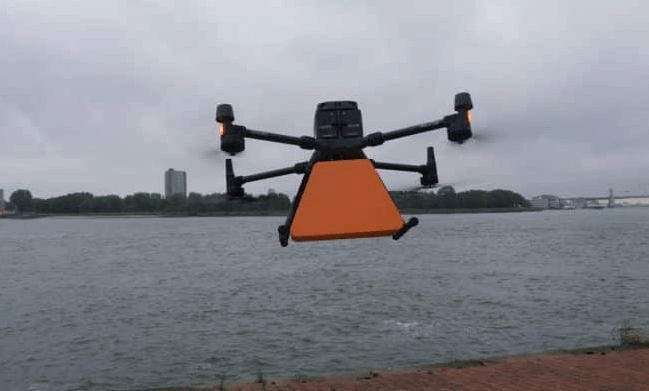Dutch Drone Delta held a new trial during which a drone delivered a package to the inland vessel Duancis.
During this operation on Monday, Duancis was moving at normal speed along the waterway near Brienenoord Island. This was the second of a series of trial flights with delivery drones in the port of Rotterdam.
Earlier this year, a drone delivered a package to the deck of the offshore vessel Pioneering Spirit, while it was moored at Maasvlakte’s Alexiahaven. The flights are intended to determine whether drone deliveries can increase efficiency in the port of Rotterdam, as well as simplify circulation in the port area for its users.
Drone development is in full swing, and this technology could well have a major impact on traffic and transport. New European regulations have cleared the way for new applications. Ultimately, this may even include autonomous unmanned freight and passenger transport. To this end, the next few years will be devoted to the phased preparation of airspace and drone technology. The recent trials constitute a significant first step in this process, since they involve the delivery of an actual package following a long-distance flight by the drone. In this case, the flight was still directly monitored by human observers, but in the near future it will take place beyond the pilot’s physical line of sight. To ensure that flights can proceed safely and efficiently outside the pilots’ field of vision, we need a reliable mobile data network at the drones’ flying altitude. Network operator KPN was involved in the current trial and performed the necessary network measurements.
Some inland vessels only call on the port for a short time. The crew may not always have time to put a car ashore to collect specific items. In this event, e.g. ordering parts online and having them delivered by drone could save a lot of time.
If a share of all the deliveries in the port area is handled by drones, this can result in a far quieter port area. After all, drones are electrically powered. But of course, drones still aren’t completely silent. That is why Dutch Drone Delta is also examining whether it is desirable to maintain a certain distance from residential areas during deliveries, and if so, how great this should be.
Moreover, these types of trials also provide initial answers to various key questions held by the providers of drone services. Which routes need to be developed, how much weight should a drone be able to transport, and where do drone deliveries fit within the logistics chain?
In the Dutch Drone Delta, a number of Dutch parties have bundled their knowledge and expertise to promote the deployment of drones for large-scale transport and logistics (Urban Air Mobility, UAM) in the airspace of the Netherlands. In January 2020, the consortium set to work on realising the prerequisites for the successful implementation of drone technology and Urban Air Mobility in Dutch society, including public acceptance of this application and safe cooperation with the other users of the airspace. Drones can be used for anything from medical deliveries, security and infrastructure inspections to the transport of freight and passengers by air, and as such can contribute clear added value to our society. Partners include KLM Royal Dutch Airlines, Air Traffic Control the Netherlands (LVNL), Royal Schiphol Group, Port of Rotterdam Authority, KPN, a.s.r. schadeverzekeringen, Antea Group, Space53 and Royal NLR. The consortium works closely together with the Dutch Ministry of Infrastructure and Water Management and Rijkswaterstaat.
